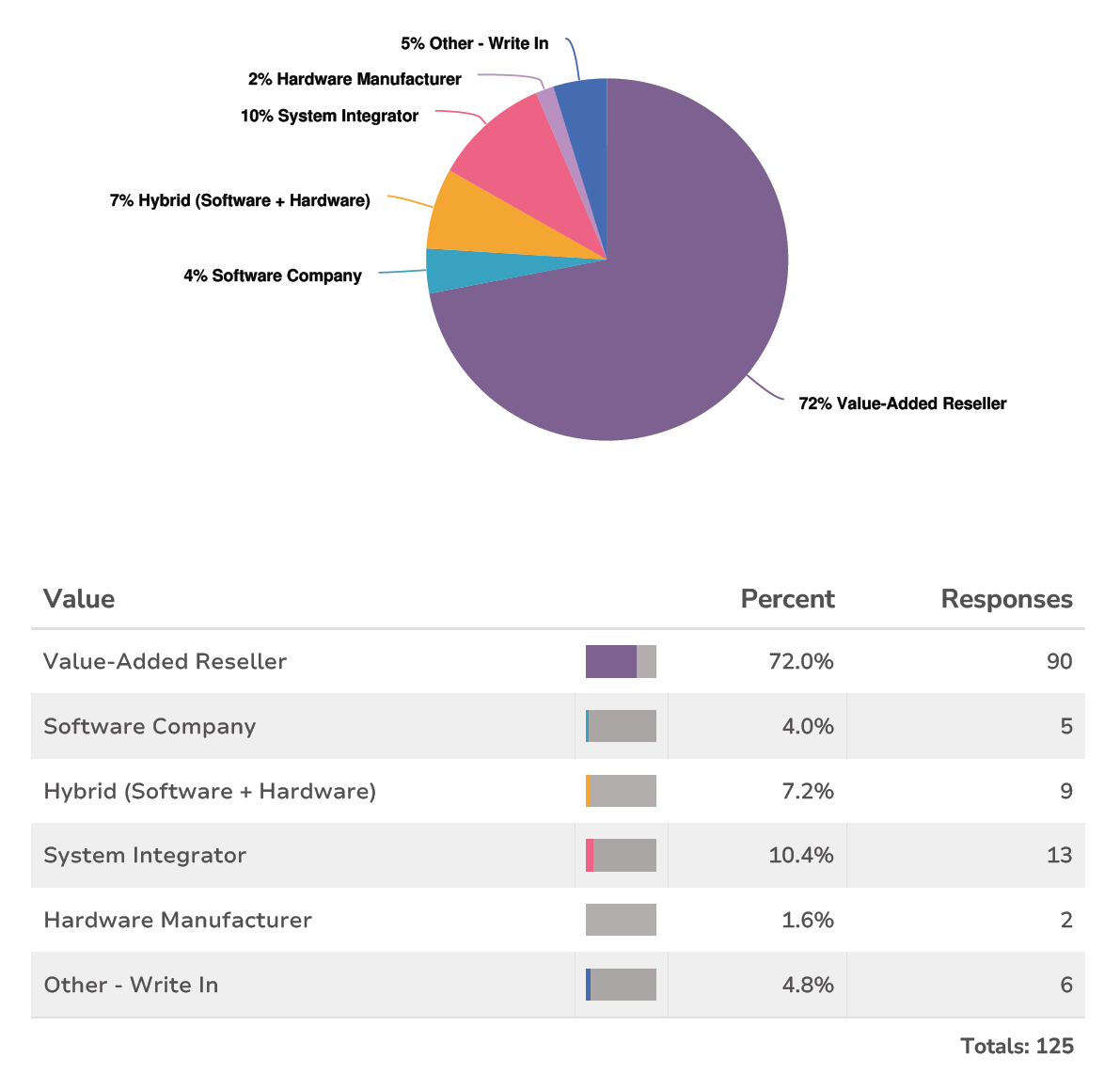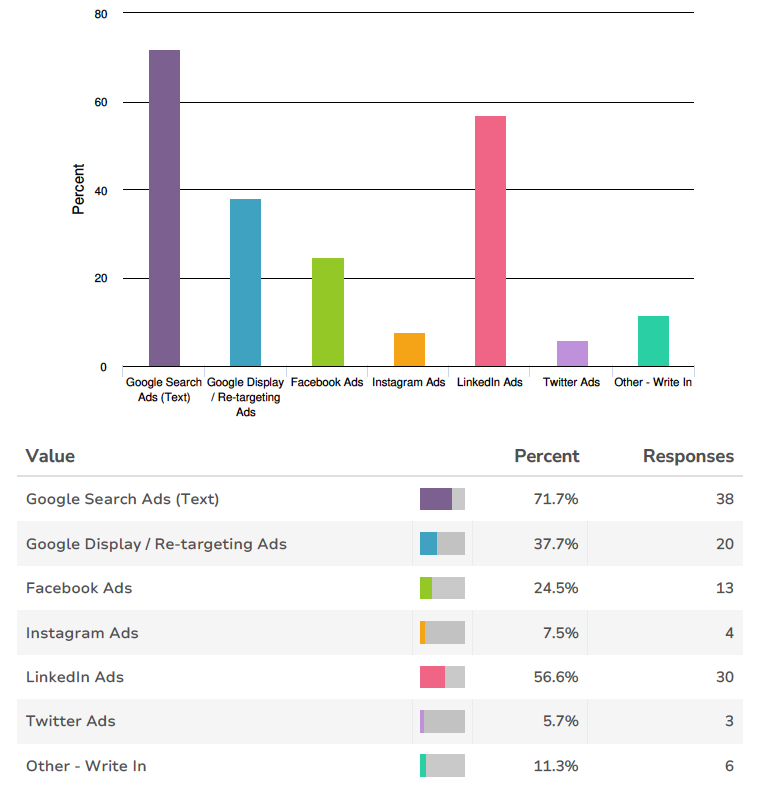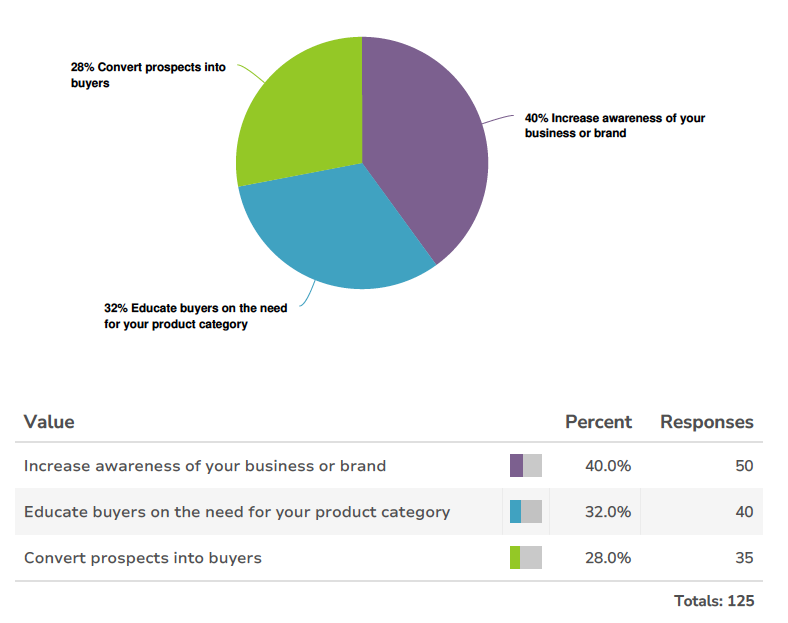2024 Solution Provider Marketing Survey: Standing Out in a Crowded Market
Where should the marketing team person spend their time? Which channels, tools, and events should we invest in?
BlueStar stocks, markets, and ships the top equipment manufacturers in rugged mobile computing, scanning, barcode, label, and receipt printer, self-service, digital signage, RFID, and edge compute.
Partner Programs

Software companies—join TEConnect to grow your business through vendor and value-added reseller partnerships
Custom Configuration
Financial Services
Installation & Site Surveys
Technical Support
Demand Lab Marketing
In-a-Box Series™ Solutions
TEConnect Software Program
Global Care
7 min read
 James Korte
Aug 28, 2022 11:06:13 AM
James Korte
Aug 28, 2022 11:06:13 AM

We asked 124 individuals—a mix of value-added resellers, system integrators, and software companies—the following: whether they ran paid advertising, how big their marketing teams are, and what their biggest marketing-related challenges are.
We wanted to get a better idea of what our partners think marketing should do for their organization, how they are tackling going to market, and where they are feeling the most pain.
Some results were expected (most reseller and ISV marketing teams are three people or fewer), and others were less predictable (over half of the companies who responded are running paid LinkedIn advertising).
There are several common challenges, which we'll explore, along with some advice on how to make marketing work harder for your company in 2022 and beyond.
We sent (2) emails to a group of over 1,400 BlueStar partners in the United States. These companies range from publicly traded to SMB and focus on markets from supply chain to retail and everything in between.
All respondents were entered into a drawing to win one of two $50 digital Amazon gift cards.
Our first question was meant to classify the respondent companies by company type. We wanted you to understand the types of business you are hearing from, and it was also helpful for BlueStar to know how the partners in our contact database self-identify. Nearly three quarters (72% or 90 respondents) identified as non-software selling value-added reseller companies.

This question was about understanding the resources at a company's disposal. Our hypothesis (based on years of interactions and in-person marketing sessions) was that most companies had a small group dedicated to marketing—and that hypothesis proved to be mostly true.
10% of respondents (13 individuals) indicated they had no one dedicated to marketing. 69% (86 individuals) of respondents had teams they were between 1-3 people, and 21% (26 responses) indicated a team of 4 or more.

Based on what we thought we knew about our partner base, we guessed that most companies were not running paid ads—but we were wrong. As it turned out, 42% of the companies who responded confirmed that they are running paid ads—with 38 out of 53 "yes" responses indicating they were spending money on Google search advertising.

For those who said they were running paid ads, we asked them to drill down a layer deeper to indicate which platforms they were investing with. We were not surprised to find Google Search Ads leading the pack, but we were pleasantly surprised to see that almost 57% (30 individuals) are experimenting with LinkedIn's ad platform. We have some advice for LinkedIn advertisers in the conclusion).

None of these answers are wrong, we just felt that one is more right than the rest, and we wanted to take the temperature of our partners on this topic.

Opinions were split here, unsurprisingly.
In our opinion, marketing should do all of the above—but it should primarily focus on educating potential buyers on the need for your product category. You'll never get someone to buy a Tesla if you don't first convince them that electric vehicles are worthy of their dollars, and you'll never get someone to buy into warehouse automation if you can't first convince them that relying on spreadsheets and manual inventory counts are causing them more pain than they realize.
Of course, our marketing should also speak to our specific products, services, and differentiators, so it will, as a result, also increase awareness of our business and brand.
Lastly, 28% of respondents thought that the primary goal of marketing should be to convert prospects into buyers—this may be a bit of semantics—but we believe that outside of inexpensive direct-to-consumer eCommerce products or product-led software products (free trial style), marketing is meant to educate buyers at scale to the point where they're ready to talk to sales—and that ultimately it's the job of the sales team to convert prospects into buyers.
Most BlueStar partners operate in complex sales environments where marketing (by itself) is highly unlikely to take a prospect from brand unaware to adding to the cart—in fact, not many of our partners even operate in an eCommerce fashion since their offerings include customized service and support contracts.
The primary goal of marketing should be to make the sales job easier because we've sold the prospect on the need for our category of products as well as explained to them how we can uniquely solve their problems with our differentiated offering.
Respondents were asked to tell us about their biggest marketing challenges in an open field with no prompts.
We went one by one and categorized the feedback into buckets—based on that categorization; these were the biggest marketing challenges facing value-added reseller companies:
Below are some of the verbatim quotes sorted under the appropriate bucket.
"Our biggest challenge is being a very small company and trying to market against a juggernaut like (redacted)."
"Handling the marketing for our various offerings with such a small team. Our marketing team puts in a heroic effort to get all their varied responsibilities done."
"To have enough time to be strategic amidst all the tactical tasks that keep getting in the way due to all the daily changes.
"Our biggest marketing challenge is always looking to the future and where we should be investing our time and money to get the best return."
"Getting the right people to take time from their busy schedules to actually understand and strategize on how the business can benefit from marketing expertise."
"As a salesperson, I always feel like Marketing needs a consultant in Sales to team up with them, so they know what we truly need to move the dial and add value."
"Audience/trying to stand out from all the other companies. Time. Time to keep up with it all."
"Awareness & education of the value our product offers to channel and end-users."
"[Finding the] time to focus on it, we need automation."
"Time to properly choose a strategy with guaranteed results.
"Cash."
"Funding Marketing Projects and measuring the ROI."
"Getting good content to our customers."
"Our challenge would be that we have a lack of content creation with such a small team."
Value-added reseller companies are operating in competitive markets, and in some cases, they're competing with venture-funded startups that have built considerable brand awareness over a short period.
Marketing teams are small, tasked with many things, are budget-strapped, and suffer from a lack of executive buy-in and strategic leadership.
Lastly, marketing is hard. Even with ample funding, time investment, and executive buy-in, there are no guarantees of success. As one savvy respondent put it, marketing suffers from a lack of standardization around measurement and expectation.
I know this paints a bleak picture, but there is hope. It requires that small companies going head-to-head with larger companies behave and market like small companies competing with larger ones and use their (lack of) size to their advantage from a marketing and product strategy standpoint.
Before we dig into any tactical advice, let's get this out of the way. You're not going to excel in marketing without stitching marketing and growth thinking into the fabric of your business. You must make marketing a key part of your business.
Now for the goods.
Don't spend your precious budget on paid search advertising. If you are hell-bent on spending your money with Google, do it to protect your branded search terms. A branded search is when a user types in the name of your company ("BlueStar") instead of your product category ("ADC/POS/Digital signage distributors.").
Assuming you have SEO basics in place, your website should be the first organic result when someone searches specifically for your company—if not, you have some work to do.
However, the rub is that even if you are the first organic result for your company name, paid search results (from the big guys) will STILL show up before you if you aren't buttressing your branded search terms with paid advertising. Bid on your company name—and that's it.
Bidding on category terms can be a decent strategy to capture existing demand if you have the budget—but it can be very pricey. We have found paid search advertising to be riddled with bots, and it doesn't sit well with this digital marketer to spend upwards of $15 for a click from a robot.
Focus on organic techniques
It costs nothing (aside from time) to add 80 connections every day on LinkedIn from your personal account. This is also something you can encourage your salespeople to do from their accounts. LinkedIn doesn't enable company pages to add connections, but it's our opinion that personal accounts are an excellent way to distribute company messages. We wrote a deep dive guide on the topic. When it comes to adding connections, target companies and job titles that look like your current customers. This is the rare marketing task you can assign to an intern if you're comfortable giving them access to your LinkedIn profile.
Start doing this immediately, and continue to do this once you begin to ramp up your content creation and sharing effort (more on that in a bit) so that when the time comes, you have a relevant audience for your message.
Find the soft spots
The big players have a lot of money and a lot of customers. They're probably a great fit for some businesses, but not all of them. The benefit to competing with large companies is that they have reviews in places like G2, Software Advice, and maybe even threads dedicated to them on Reddit where you can get the scoop from current and past customers on where the big players are failing them. Use this to your advantage from a product strategy and a marketing standpoint. Craft messages that address these objections and explain how you can help alleviate the pain.
Get sharp about what makes you different
Many small companies say they are dedicated to customer service and support. We believe you, but buyers don't. Prove it. Dedicate yourself to capturing video testimonials from your current customers. Think about how you can incentivize getting these testimonials—they don't need to be highly produced; in fact, it's much better if they're not.
What else makes your company different? What proof do you need to make buyers believe it? This should be a key pillar in your content strategy.
Own a niche from a feature/benefit standpoint
For smaller companies, it's often a better strategy to limit the markets you target. Limiting the type of businesses you pursue from a sales standpoint means that your product team can also focus its strategy on those same markets, resulting in a differentiated product that offers you a unique advantage over competitors—both large and small—when it comes to closing business in that niche. Stop trying to be everything to everyone and get specific about who your customer is.
Doing things differently
Large companies tend to market like large companies. This means overt branding and ads that look like ads. It means investing big money into highly-produced content that attempts to speak to a large, diverse group of businesses. As a smaller, scrappier company, you benefit from less bureaucracy in your creative and strategic decision-making processes. You can attack underserved niches and speak to specific pain points you uncover through your competitive research. You can highlight your tenured staff, white-glove service, and other value-added aspects of your business that large organizations struggle to match.
We're passionate about marketing at BlueStar, and we believe that great marketing execution can come from businesses with small and even non-dedicated teams. It will require some work, but you didn't make it this far without a willingness to get your hands dirty.

Where should the marketing team person spend their time? Which channels, tools, and events should we invest in?

I’ve been on dozens of Zoom calls with small business owners in the IT and software space to talk marketing.

Have you ever wondered what your peers value in the products they choose to resell?